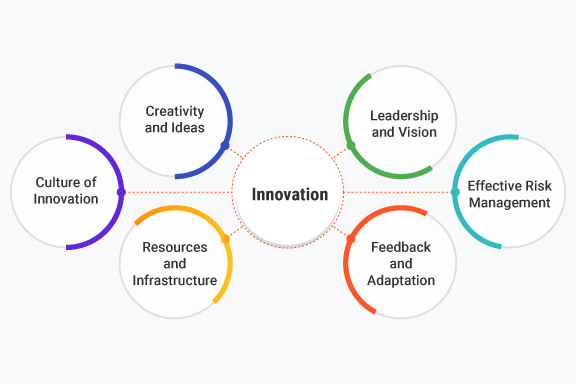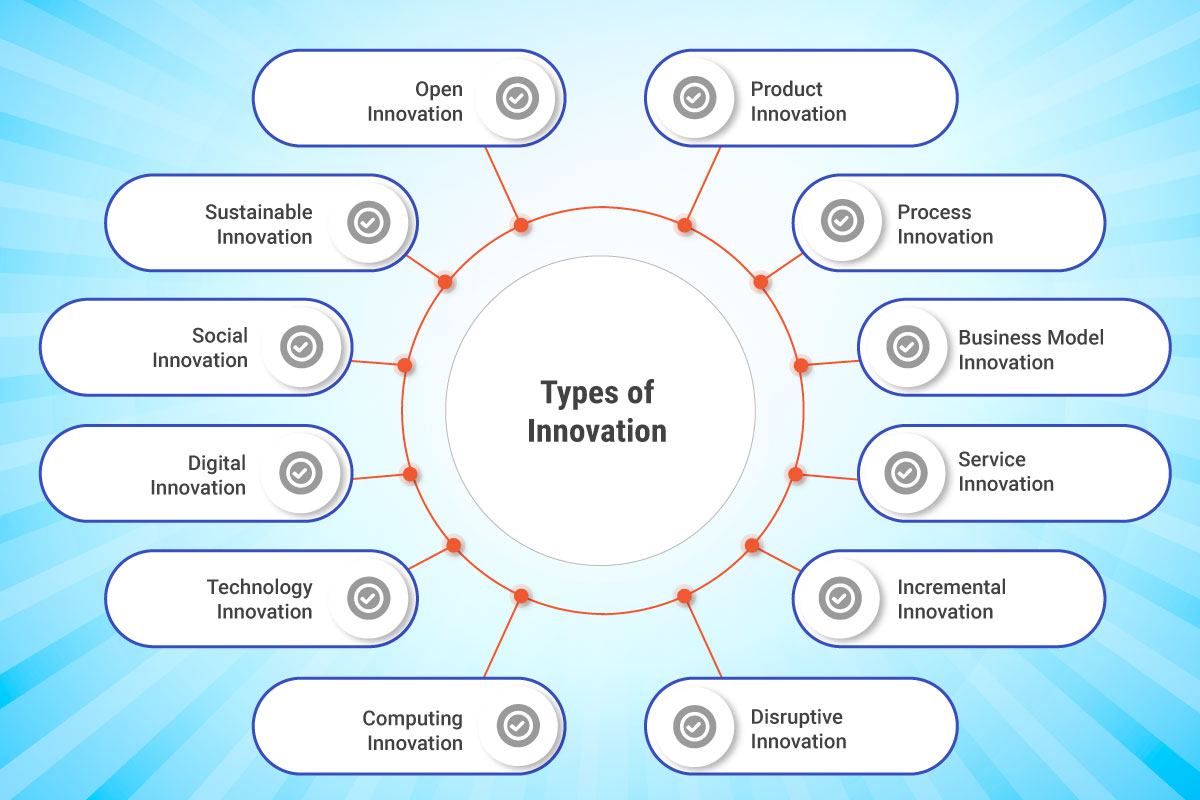

Innovation is defined as the process of bringing about new ideas, methods, products, services, or solutions that have a significant positive impact and value. It involves transforming creative concepts into tangible outcomes that improve efficiency, and effectiveness, or address unmet needs.
Innovation is not limited to technological advancements and encompasses novel approaches to problem-solving, processes, organizational practices, or business model innovations. At its core, innovation involves challenging the status quo, thinking outside the box, and taking calculated risks to drive progress and achieve breakthrough outcomes.
Innovation is driven by a combination of factors, including curiosity, creativity, and the desire for improvement. It requires a mindset that embraces change, welcomes ideation, and encourages experimentation. Innovation can occur in various contexts, such as business, science, technology, social sectors, or public services. It can lead to economic growth, social progress, improved quality of life, and sustainable development.
Key components that make innovation possible in an organization
Several key components contribute to making innovation possible in an organization. These components provide the foundation and enable organizations and individuals to drive innovation effectively. Here are the key essential components:

Innovation manifests in diverse forms, each serving unique purposes and delivering distinct benefits. Explore the key types of innovation crucial for modern businesses:
Furthermore, any of the above types of innovation can be approached through continuous innovation or discontinuous innovation:
Each type of innovation offers distinct advantages and strategic opportunities for organizations aiming to innovate effectively in today’s dynamic market landscape. Implementing a tailored innovation strategy that integrates these types can propel your business towards sustained growth and market leadership.
Here are the ten best innovation examples from various industries:
1. Airbnb: Airbnb disrupted the traditional hospitality industry by creating an online marketplace that allows individuals to rent out their homes or spare rooms to travelers. This peer-to-peer accommodation model provided an alternative to traditional hotels and revolutionized the way people travel and experience accommodations.
2. Electric Vehicles: Electric vehicles by brands like Tesla, have revolutionized the automotive industry by pioneering electric vehicles (EVs) that offer long-range capabilities, high-performance features, and sustainable energy solutions. Their technology innovation in battery and charging infrastructure has played a significant role in accelerating the adoption of EVs worldwide.
3. SpaceX’s Reusable Rockets: SpaceX, founded by Elon Musk, developed reusable rockets that can be landed and reused, significantly reducing the cost of space exploration and making space travel more accessible. This innovation has opened up new possibilities in the aerospace industry.
4. 3D Printing: 3D printing, also known as additive manufacturing, has transformed various industries by enabling the production of complex and customized objects with precision. It has revolutionized manufacturing, healthcare (e.g., prosthetics), and design prototyping, among other sectors.
5. CRISPR Gene Editing: CRISPR-Cas9 is a revolutionary gene-editing technology innovation that enables precise and efficient modification of DNA sequences. This innovation has the potential to revolutionize healthcare, agriculture, and biotechnology by offering new approaches to treating genetic diseases, enhancing crop resilience, and developing new therapies.
6. Netflix’s Streaming Service: Netflix disrupted the traditional video rental and television industry by introducing a streaming service that allows users to watch movies and TV shows on demand. This innovation led to a shift in how content is consumed, paving the way for other streaming platforms.
7. Mobile Payment Solutions: Companies like Apple Pay, Google Pay, and PayPal have transformed the way payments are made by enabling secure and convenient mobile transactions. This innovation has simplified payment processes and enhanced financial inclusivity.
8. Amazon’s Alexa Voice Assistant: Amazon’s voice-controlled assistant, Alexa, introduced a new way of interacting with technology leveraging digital innovation through natural language processing. It has revolutionized the smart home industry and paved the way for voice-controlled devices and services.
9. Electric Scooters and Bike-Sharing Services: Electric scooters and bike-sharing services, such as Lime and Citi Bike, have provided eco-friendly alternatives for urban transportation. These innovations have facilitated short-distance travel, reduced congestion, and promoted sustainable mobility options.
10. Solar Energy Technologies: Advancements in solar energy technologies, including more efficient photovoltaic cells and cost reductions, have made solar power increasingly accessible and economically viable. This innovation has driven the growth of renewable energy sources and contributed to the transition towards a sustainable energy future.
These examples showcase the transformative power of innovation across various sectors, highlighting how ideation and advancements can reshape industries, improve lives, and drive positive change.

The innovation process typically involves a series of key steps that organizations follow to foster and implement innovation. While specific approaches may vary, here are the common steps involved in the innovation process:
Step 1. Identify Opportunities
The first step is to identify opportunities for innovation. This can be done through market research, customer insights, trend analysis, or internal assessments. The goal is to uncover unmet needs, emerging trends, or areas for improvement that can be addressed through innovation.
Step 2. Generate Ideas
Once opportunities are identified, the next step is to generate ideas. This can be done through brainstorming sessions, idea competitions, customer feedback, or cross-functional collaboration. The aim is to generate a wide range of creative and innovative ideas that have the potential to address the identified opportunities.
Step 3. Evaluate and Select Ideas
After ideation, the next step is to evaluate and select the most promising ones. This involves assessing the feasibility, viability, and desirability of each idea. Consider factors such as market potential, technical feasibility, resource requirements, alignment with strategic goals, and potential impact. The goal is to identify the ideas that are worth pursuing further.
Step 4. Develop and Prototype
Once ideas are selected, they can be further developed and prototyped. This involves translating the selected ideas into tangible prototypes, mock-ups, or minimum viable products (MVPs). The aim is to test and validate the concepts, gather feedback, and refine the ideas based on customer insights and technical feasibility.
Step 5. Test and Iterate
In this step, the prototypes or MVPs are tested with users or in real-world scenarios. Customer feedback is collected, and the concepts are iterated and refined based on the insights gained. This iterative process helps to validate assumptions, uncover potential issues, and improve the innovation before moving to the next stage.
Step 6. Implement and Scale
Once the innovation has been tested and refined, it can be implemented and scaled up. This involves developing a detailed implementation plan, allocating resources, and executing the necessary actions to bring the innovation to market or implement it within the organization. The goal is to ensure a smooth transition from the development phase to full-scale implementation.
Step 7. Monitor and Evaluate
After implementation, it is important to monitor and evaluate the performance and impact of the innovation. This involves tracking key metrics and performance indicators to assess the success of the innovation. Regular evaluation helps identify areas for improvement, make necessary adjustments, and capture learnings for future innovation initiatives.
Innovation is an ongoing process, and organizations should foster a culture of innovation. This involves capturing feedback, promoting learning from both successes and failures and continuously seeking new opportunities for innovation. Regularly revisiting and refining the innovation process itself is also essential to optimize the organization’s ability to innovate effectively.